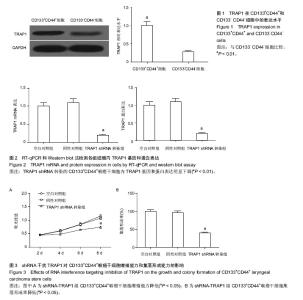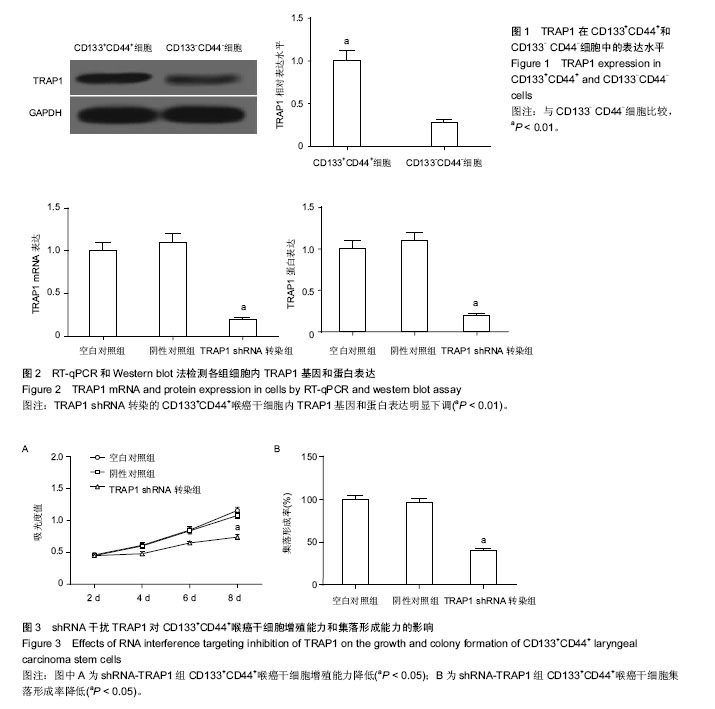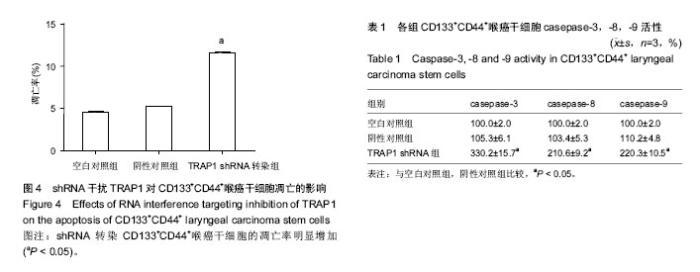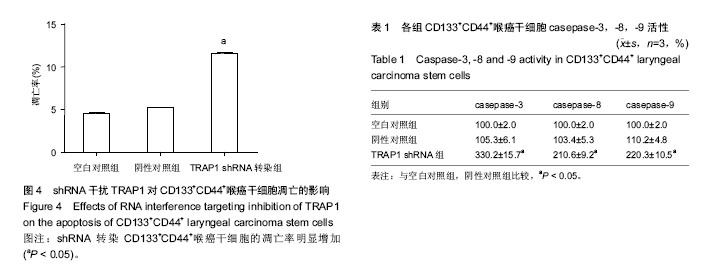| [1] Fung C, Grandis JR. Emerging drugs to treat squamous cell carcinomas of the head and neck. Expert Opin Emerg Drugs. 2010;15(3):355-373.[2] Ragin CC, Modugno F, Gollin SM.The epidemiology and risk factors of head and neck cancer: a focus on human papillomavirus.J Dent Res. 2007;86(2):104-114.[3] 刘天润,杨安奎,陈福进,等. 221例晚期喉鳞癌患者术后的生存和预后分析[J].癌症,2009,28(3):297-302.[4] Pridgeon JW, Olzmann JA, Chin LS, et al. PINK1 protects against oxidative stress by phosphorylating mitochondrial chaperone TRAP1. PLoS Biol. 2007;5(7):e172.[5] Zhang P, Lu Y, Yu D, et al. TRAP1 Provides Protection Against Myocardial Ischemia-Reperfusion Injury by Ameliorating Mitochondrial Dysfunction. Cell Physiol Biochem. 2015;36(5):2072-2082.[6] Zhang L, Karsten P, Hamm S, et al. TRAP1 rescues PINK1 loss-of-function phenotypes. Hum Mol Genet. 2013;22(14): 2829-2841.[7] Lisanti S, Tavecchio M, Chae YC, et al. Deletion of the mitochondrial chaperone TRAP-1 uncovers global reprogramming of metabolic networks. Cell Rep. 2014;8(3): 671-677.[8] Zhang B, Wang J, Huang Z, et al. Aberrantly upregulated TRAP1 is required for tumorigenesis of breast cancer. Oncotarget. 2015;6(42):44495-44508.[9] Nguyen MC, Tu GH, Koprivnikar KE, et al. Antibody responses to galectin-8, TARP and TRAP1 in prostate cancer patients treated with a GM-CSF-secreting cellular immunotherapy. Cancer Immunol Immunother. 2010;59(9):1313-1323.[10] Landriscina M, Amoroso MR, Piscazzi A, et al. Heat shock proteins, cell survival and drug resistance: the mitochondrial chaperone TRAP1, a potential novel target for ovarian cancer therapy. Gynecol Oncol. 2010;117(2):177-182.[11] Im CN, Seo JS. Overexpression of tumor necrosis factor receptor-associated protein 1 (TRAP1), leads to mitochondrial aberrations in mouse fibroblast NIH/3T3 cells. BMB Rep. 2014;47(5):280-285.[12] Chen R, Pan S, Lai K, et al. Up-regulation of mitochondrial chaperone TRAP1 in ulcerative colitis associated colorectal cancer. World J Gastroenterol. 2014;20(45):17037-17048.[13] Tian X, Ma P, Sui CG, et al. Suppression of tumor necrosis factor receptor-associated protein 1 expression induces inhibition of cell proliferation and tumor growth in human esophageal cancer cells. FEBS J. 2014;281(12):2805-2819.[14] Agorreta J, Hu J, Liu D, et al. TRAP1 regulates proliferation, mitochondrial function, and has prognostic significance in NSCLC. Mol Cancer Res. 2014;12(5):660-669.[15] Ernst JT, Liu M, Zuccola H, et al. Correlation between chemotype-dependent binding conformations of HSP90α/β and isoform selectivity-Implications for the structure-based design of HSP90α/β selective inhibitors for treating neurodegenerative diseases. Bioorg Med Chem Lett. 2014; 24(1):204-208.[16] Maddalena F, Sisinni L, Lettini G, et al. Resistance to paclitxel in breast carcinoma cells requires a quality control of mitochondrial antiapoptotic proteins by TRAP1. Mol Oncol. 2013;7(5):895-906.[17] Palladino G, Notarangelo T, Pannone G, et al. TRAP1 regulates cell cycle and apoptosis in thyroid carcinoma cells. Endocr Relat Cancer. 2016;23(9):699-709.[18] Lisanti S, Garlick DS, Bryant KG, et al. Transgenic Expression of the Mitochondrial Chaperone TNFR-associated Protein 1 (TRAP1) Accelerates Prostate Cancer Development. J Biol Chem. 2016;291(48):25247-25254.[19] Lettini G, Sisinni L, Condelli V, et al. TRAP1 regulates stemness through Wnt/β-catenin pathway in human colorectal carcinoma. Cell Death Differ. 2016;23(11):1792-1803.[20] Lv Q, Sun H, Cao C, et al. Overexpression of tumor necrosis factor receptor-associated protein 1 (TRAP1) are associated with poor prognosis of epithelial ovarian cancer.Tumour Biol. 2016;37(2):2721-2727.[21] 沈培亮,刘兆国,孙丽华,等.肿瘤治疗新靶点TRAP1研究进展[J].中国药理学通报,2016,32(4): 459-462,463.[22] Guzzo G, Sciacovelli M, Bernardi P, et al. Inhibition of succinate dehydrogenase by the mitochondrial chaperone TRAP1 has anti-oxidant and anti-apoptotic effects on tumor cells. Oncotarget. 2014;5(23):11897-11908.[23] Im CN. Past, present, and emerging roles of mitochondrial heat shock protein TRAP1 in the metabolism and regulation of cancer stem cells. Cell Stress Chaperones. 2016;21(4): 553-562.[24] Cho SG, Choi EJ. Apoptotic signaling pathways: caspases and stress-activated protein kinases. J Biochem Mol Biol. 2002;35(1):24-27.[25] Fan TJ, Han LH, Cong RS, et al. Caspase family proteases and apoptosis. Acta Biochim Biophys Sin (Shanghai). 2005; 37(11):719-727.[26] Slee EA, Harte MT, Kluck RM, et al. Ordering the cytochrome c-initiated caspase cascade: hierarchical activation of caspases-2, -3, -6, -7, -8, and -10 in a caspase-9-dependent manner. J Cell Biol. 1999;144(2):281-292.[27] Kang BH, Plescia J, Dohi T, et al. Regulation of tumor cell mitochondrial homeostasis by an organelle-specific Hsp90 chaperone network. Cell. 2007;131(2):257-270.[28] Landriscina M, Amoroso MR, Piscazzi A, et al. Heat shock proteins, cell survival and drug resistance: the mitochondrial chaperone TRAP1, a potential novel target for ovarian cancer therapy. Gynecol Oncol. 2010;117(2):177-182.[29] Li S, Lv Q, Sun H, et al. Expression of TRAP1 predicts poor survival of malignant glioma patients. J Mol Neurosci. 2015; 55(1):62-68.[30] Im CN, Seo JS. Overexpression of tumor necrosis factor receptor-associated protein 1 (TRAP1), leads to mitochondrial aberrations in mouse fibroblast NIH/3T3 cells. BMB Rep. 2014;47(5):280-285.[31] Tian X, Ma P, Sui CG, et al. Suppression of tumor necrosis factor receptor-associated protein 1 expression induces inhibition of cell proliferation and tumor growth in human esophageal cancer cells. FEBS J. 2014;281(12):2805-2819.[32] Takamura H, Koyama Y, Matsuzaki S, et al. TRAP1 controls mitochondrial fusion/fission balance through Drp1 and Mff expression. PLoS One. 2012;7(12):e51912. |



